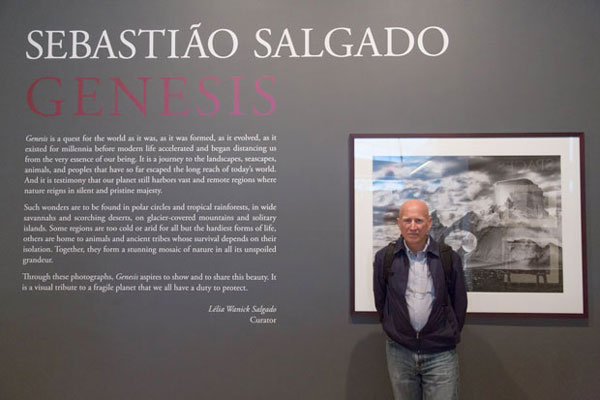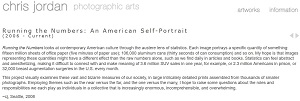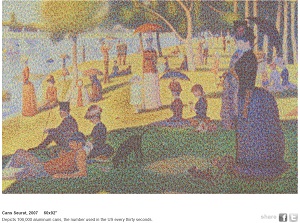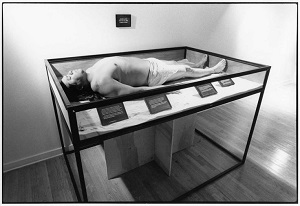| Items
and Highlights |
Exhibition
Curator Notes
|
Peer
Comments/Guest Book
|
'Dulce
et Decorum Est': A Close Reading
Items
- Wilfred Owen, poetry manuscripts, 1911–18, British
Library
- John Keats, manuscript of "The Eve of St Mark,"
1820, British Museum Library
- Jessie Pope, Jessie Pope's War Poems,
1915, British Library
- The Hydra, Nov. 1917, British
Library
- W. H. R. Rivers, "An Address on the Repression of War
Experience," The Lancet, 2 Feb. 1918, British
Library
|
Santanu Das: Today, the
manuscript of 'Dulce Et Decorum Est' teases us with its
combination of meaning and materiality as we find his 'large and
sloping' hand thinking and feeling its way through the shape and
sound of words with many crossings-out and revisions into his
'charred' senses. At one point, Owen replaces the word 'clawing'
with 'haunting'. The poem itself is a 'haunting', marked as much
by his memories of the front as by his growing sense of duty as a
war-poet: 'My subject is War and the Pity of War. The poetry is in
the pity'. Yet, in a paradox characteristic of the First World
War, the war-haunted document is also an ode to literary
friendship forged at Craiglockhart.
|
|
An
Introduction to Animal Farm
Items
- George Orwell, "I like
animals," quote.
- Dennis Collings, Photograph of Orwell feeding Muriel the goat,
1939, UCL Library
- George Orwell, Domestic diary, May 1939, UCL
Library
- George Orwell, "Impenetrable Mystery," review of Assignment
in Utopia by Eugene Lyons, 9 Jun. 1938, New English
Weekly, Sonia Brownell Orwell estate
- T. S. Eliot, letter to Orwell rejecting Animal Farm,
13 Jul. 1944, Faber and Faber, British Library
|
John
Sutherland: George Orwell is famous as a political writer,
essayist, thinker and, supremely, novelist. One can easily
overlook another consistent feature in Orwell’s life—his desire to
be a small-holding farmer of an old-fashioned ‘English’ kind. It
crops up in rather odd ways.
Living in London during the Second World War, for example, he kept
chickens in the backyard (his wife, Eileen, rather resented
getting up at dawn, after a night of air-raid alarms to feed
them). His longest-lasting residence was a cottage in Wallington,
near London, where he kept chickens, goats and geese (a fowl he
particularly liked).
|
|
Angela
Carter: Gothic Literature and The Bloody Chamber
Items
- Angela Carter, "The Cabinet of Edgar Allan Poe," draft
essay on Poe and his short story "The Fall of the House of
Usher," c. 1983, Estate of Angela Carter
- Charles Perrault, "The Fairy Tales of Charles Perrault,"
translated by Angela Carter, 1977, Estate of Angela Carter
- Angela Carter, typescript draft of "The Sadeian Woman,"
c. 1977, Estate of Angela Carter
- Angela Carter, manuscript notes and drafts of The
Bloody Chamber, British Library
|
Greg
Buzwell: Like every great author of Gothic fiction, Angela
Carter was blessed with an intensely vivid and extremely dark
imagination. Gothic imagery permeates all of her work but nowhere
more so than in The Bloody Chamber (1979), a collection of
tales that delights in moonlit forests, graveyards, isolated
castles, locked rooms, guttering candles and the howling of wolves
in the night. The stories in The Bloody Chamber primarily have
their origins in fairy tales, but Carter gave these old and
much-loved narratives a radical twist, providing a feminist
perspective to stories in which the female characters were young,
demure and helpless or else old, haggard and witch-like. As Carter
commented in her essay ‘Notes from the Front Line’, ‘I am all for
putting new wine in old bottles, especially if the pressure of the
new wine makes the old bottles explode’. Carter also took
inspiration from Gothic literature’s rich heritage, adapting
themes and motifs from classic tales of terror and giving them her
own uniquely individual slant. |
|
Faces of Frida
Items
- "Huipil," Appearances Can Be Deceiving, Museo
Frida Kahlo
- Renata Blaisten, "The Blue
House," What Was Frida's Life Like?, Collecion
Blaisten
- Didier Schulmann, "Letter
to Nickolas Muray,"1939, Frida Kahlo in Paris
- "Diary page on the meaning
of colors," A Peek at Frida Kahlo's Diary, Museo
Dolors Olmedo
Highlights
and Features
|
Jesús
Garcia: It's a true global effort. Frida's name kept coming
up as a top contender when we started to think of what artist
would be the best to feature in a retrospective. There's so much
of her that was not known and could still be explored from an
artistic perspective and life experience.
|
|
Virginia Woolf: Art,
Life and Vision
Items
- George Charles Beresford, Virginia Woolf, National
Portrait Gallery
- Vanessa Bell, Virginia Woolf, c 1912, National
Trust
- Gisele Freund, Virginia and Leonard Woolf, 1939,
IMEC Images
- Black Book, 1940, Imperial
War Museum (a list of people to be arrested and
imprisoned in the invasion of Britain by Nazi Germany; both
Woolf and her husband are listed)
- Virginia Woolf, last letter to Vanessa Bell, British
Library
- Virginia Woolf's walking stick, New
York Public Library (found
in 1941 by Leonard Woolf on the banks of the River Ouse the
day Woolf went missing)
Highlights and Features
|
Frances
Spalding: This exhibition introduces you to aspects of
Virginia Woolf's life and work, more or less in a chronological
order, but it also contains awareness of new interests in her work
and hopefully introduces things that you won't have heard of
before.
|
|
Agatha Christie:
Unfinished Portrait
Items
- Photographs of young Agatha Christie at her
home Ashfield, Torquay, Devon, c. 1895, Daily Mail,
Jul. 2019.
- Photographs of young Agatha Christie at her
home Ashfield, Torquay, Devon, c. 1897, Jersey
Evening Post, 3 Jul. 2019.
- Photograph of young Agatha Christie playing
mandolin, c. 1898, The Shorely, Sep. 2019.
- Photograph of Agatha Christie in dancing
class at Torquay, International Agatha Christie
Festival, May 2017.
- Photograph of Agatha Christie surfing, Artnet,
18 Jun. 2015.
Bankside
Gallery
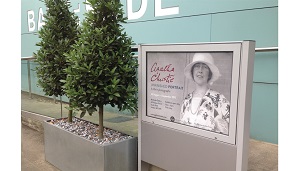
|
Alice
Graham: In order to put this exhibition together, I worked
very closely with the Agatha Christie archive and with Agatha
Christie's grandson. It was very important to really understand
the character of Agatha and bring that out through the exhibition,
so there was a lot of work done in trying to understand her
character before we even began. I had the privilege of searching
the archive for photographs to represent her entire life and also
looking through all her papers, her letters, everything she wrote
really, if it's in her private archive to put quotes together with
the pictures. So the idea is you feel like Agatha is actually
showing you around the exhibition.
I've become very fond of Agatha through the process of curating
this exhibition. She was such a fun lady, and she's sort of like
the grandma we all want really. You know she had this amazing
career, but actually, behind the scenes, she was loving and great
fun.
|
|
Joseph
Conrad: Twixt Land and Sea
|
Katarzyna
Jakimiak and Elzbieta Szymanska: The title of the
exhibition, derived from a collection of Conrad's short stories Twixt
Land and Sea (1912), is meant to serve as a metaphor.
However, it does not intend to refer only to life choices of the
writer and places where his characters function. The title opens
the space between the land and the wide sea for dreams, feelings,
moral choices, remembrances and—above all—the art. Conrad will
guide you through this realm with fragments of his works and
letters. |
|
The Powerful Potato
|
|
|
Football Boots: The
Evolution of Soccer in Footwear
|
|
|
Q?rius
|
|
|
Sounds of the Arctic
|
|
|
Tolkien: Maker of Middle Earth
|
|
|
